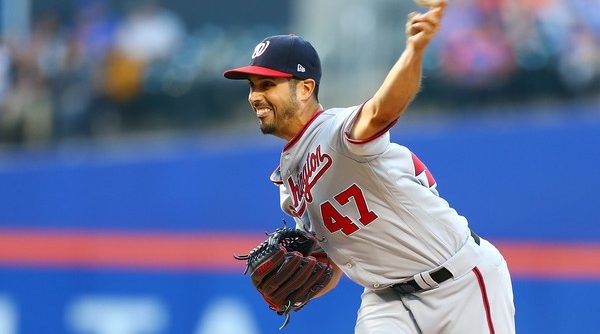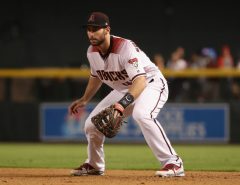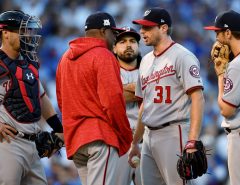Good Gio and Bad Gio. Every Nationals’ fan has seen these split personalities of enigmatic pitcher Gio Gonzalez. Good Gio is exciting — sometimes awe inspiring. Bad Gio is flat out frustrating to watch. In 2016, the Nationals saw more of Bad Gio than Good. So far in 2017, though, Bad Gio has been mostly absent. What has happened to Bad Gio?
Heading into Gio’s start later tonight, he’s sporting a shiny 2.89 ERA over 87 innings of work spread over two and a half months. Bad Gio hasn’t been non-existent. Gonzalez was awful in an outing against the Orioles, allowing six runs on the road in Baltimore. He also gave up four runs to the lowly Braves in Atlanta. But outside of those two disappointments, Good Gio hasn’t allowed more than three runs in any other outing.
After Gio’s hot start to the year, TNB writer Nathaniel Brose pointed out all the reasons to expect Bad Gio to start popping up more often: Gio was walking more batters, inducing fewer groundballs and generating fewer swings and misses. All telltale signs of a pitcher out performing his metrics. On top of that, this was a story Gio had spun before. In 2016, Gonzalez was the best pitcher in baseball over the month of April as he put up a 1.42 ERA. When the calendar turned to May, however, Bad Gio reared his ugly head and Gonzalez ended the month of May with a 5.23 ERA that was more than a full run better than his 6.95 ERA in June.
Although Gio has been solid for over two months, Brose wasn’t wrong. In fact, Gio has seen a bit of a pull back since putting up a 1.66 ERA in April, posting a 4.09 ERA in May this year. Considering his name was included in trade rumors this offseason as an expendable player, the Nationals would happily take a 4.00 ERA from Gio here on out, though. But Bad Gio is still lurking just below the surface, waiting for his chance to strike.
For one, Gio has been on the good end of BABIP luck so far in 2017. His strikeout rate of 22% is consistent with his strikeout rate last year, but his walk rate is up to 10.5%, what would be the highest of his Nationals’ career and significantly higher than his 7.7% walk rate last season. All those extra walks haven’t come back to bite Gio because he’s had good cluster luck. His strand rate (the rate of runners who reach base and never score) is a shockingly high 85%. For comparisons sake, he had a strand rate of only 68% last season and the league averages a 73% strand rate. It’s especially strange because Gio is forcing the fewest groundballs of his career, inducing groundballs that can turn into double plays to wipe out all those extra baserunners. No start of Gio’s season better exemplifies this concept than his outing against the Diamondbacks. Despite walking seven (SEVEN!) betters, Gio gave up only one earned run.
All of that points to Bad Gio just waiting to pounce. However, Gonzalez has made some changes that could keep Bad Gio at bay for a while longer. Much has been made of Gio’s dropping fastball velocity, and rightfully so. What used to be a mid-90s fastball has dropped to a mere 90 MPH so far in 2017. Gio has made the necessary adjustment to counteract this diminished velocity, though. He’s gone to his curveball a lot more than he did in the past and has also upped the usage of his changeup. Those changes have made his fastball more effective this year and he’s actually getting better results with the pitch than he did last year despite the slower speed. Those changes have made Gio a better pitcher this season and allowed him to go deeper into ball games, averaging over 6 innings per outing this season.
So, no, Bad Gio is not gone for good. And it wouldn’t be a true Nationals season without a Gio meltdown or two during the dog days of summer. But, Gio has made some adjustments this season that might turn Bad Gio into Sub-Par Gio. After the bullpen’s ongoing struggles and the disappointing performances of Tanner Roark and Joe Ross of late, the Nats need Good Gio to keep rolling.
Tags: Gio Gonzalez, Nationals, Nats, Washington Nationals




I crunched Gio’s numbers (and no longer have the data) and found a completely unexpected pattern. I found Gio had a lower ERA in the games in which he walked the most. I also found that these were the games in which he was striking the most guys out. These were also the games in which Lobaton was the starting catcher. My theory was Gio wasnt challenging hitters (especially the best hitters) but living on corners, edges. He walked a lot of guys… but also got some calls and struck some out. My theory as to what has carried over the most and spelled success the most for Gio is that he doesnt care too much if he walks a great hitter or two. Rather walk you than give up a big hit. Definitely the bend but dont break strategy. It wont always work but does or at least has more times than not.
The numbers I examined were from 2016. When I refer to what carried over I refer to lessons learned being brought from 16′ to 17′. Hes adapting and developing and becoming more comfortable with a new strategy. Les stuff more placement.